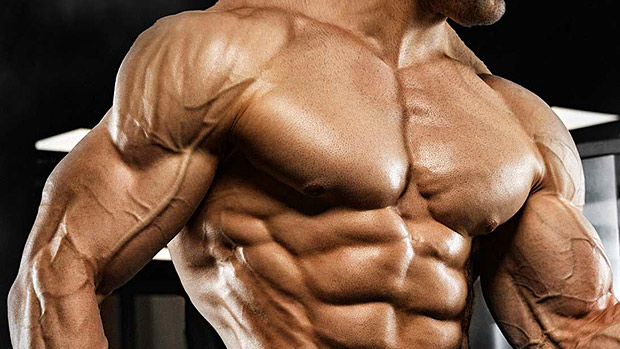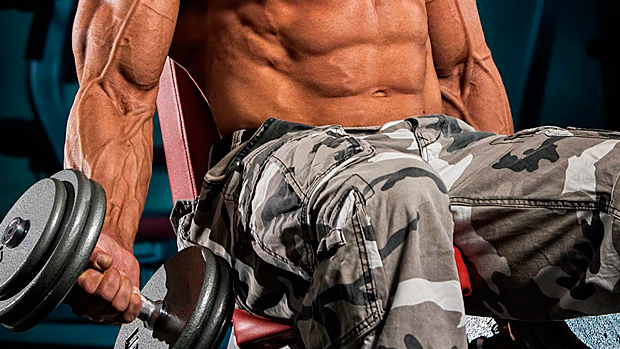Still eating the same food, following the same diet, and doing basically the same workouts? Sure, consistency is important, but if you're not making progress anymore it may be time to do the opposite, at least for a while.
Raise your carbs for a week or so. Eating more will serve as an "anabolic switch" of sorts allowing you to bust through the muscle-building plateau you're likely experiencing if you've been a low-carber for a while.
The increase in anabolism will occur primarily because of the subsequent insulin secretion (thanks to the bump in carbs) and an activation of mTOR (2).
Likewise, your training performance will be better because of the increased glycogen your muscles will store (2). Your ability to get more reps with a given weight will improve, especially on subsequent sets of an exercise or other exercises for the same body part. Getting more reps will lead to muscular hypertrophy as an adaptive response to an increase in time under tension and metabolic stress (4).
You'll also get to enjoy some skin-stretching pumps like you haven't felt in a while. Even if you don't compare a good pump to climaxing, like Arnold did, it still feels good to get your swole on.
Another, often overlooked, benefit to eating carbs is ingesting the nutrients contained in them, particularly via fruit and vegetables. Don't use your period of increased carb consumption as an excuse to eat junk. Choose healthy, nutrient-dense carb sources, including those that are high in fiber.
Expect to gain a few pounds relatively quickly, largely from increased glycogen storage. And make sure to maximize your time consuming copious carbs by training hard with a higher training volume than normal. This will maximize the amount of lean muscle mass gained during this insulin/mTOR-mediated period of increased anabolism.

Try a low-carb diet. Although you're likely to lose some excess water weight, that's just the beginning. Your body will be forced to burn fat for fuel and will get more efficient at this process (1). This is also called beta oxidation of fatty acids, which occurs in the mitochondria within cells.
Speaking of mitochondria, another adaptation to a low-carb diet is increased mitochondrial biogenesis (2). This simply means the mitochondria will grow in size and/or number. Given that the mitochondria produce energy (i.e. burn fat), this is a huge benefit. Taking a break from carbs may also help reduce inflammation (3).
When available, carbs are the preferred source of quick energy production for your body and brain. So be prepared for it to take about three days for your body to run out of stored carbs and get reacquainted with the fat-burning byproduct, ketones, for energy.
However, if you get to that point, you'll likely notice that your overall energy is stable, and your hunger and cravings are reduced. This is confirmation that your effort was well spent. After all, you want your body to be metabolically flexible – ready, willing, and able to efficiently use fat for energy.
In my experience (supported by research), occasionally doing a low-carb or ketogenic diet makes your body more efficient at burning fat regardless of what type of diet you use most of the time. This makes fat loss easier, both physically and mentally. That's metabolic flexibility in action!
That's why I recommend implementing a low-carb diet fairly regularly – to make sure your body's ready to oxidize fat. Like Snoop Dogg says, "If you stay ready, you ain't gotta get ready."

Try exercising like an athlete. After long periods of training with a traditional body part split, moderate rep speed, and the typical 8-15 reps, your body could really benefit from a change. So instead of looking at training through the lens of muscle groups, shift your focus to a movement-based, athletic approach.
Work out like an MMA fighter, football player, or do some CrossFit-style training, all of which focus more on doing explosive, athletic-type exercises that train a particular movement as opposed to a certain muscle.
Box jumps, clapping push-ups, medicine ball throws, kettlebell swings, ladder and cone drills, Olympic lifts, as well as sledgehammering and/or flipping a big-ass tire are exercises that practically never make it into a bodybuilding routine. That's precisely why they'll be of such benefit.
Explosive exercises will increase your power output and cause positive neuromuscular adaptations. For example, an increase high-threshold motor unit recruitment and rate coding, as well as hypertrophy of fast twitch, type-II muscle fibers (which happen to have the highest potential for growth) occur as a result of training for power (5).
Simply put, fast-twitch muscle fibers and the nerves that innervate them become more efficient via training explosively, leading to muscle growth.
Performing unique, dynamic movements that you don't typically do will stimulate muscles and connective tissue in a way that's foreign to them, forcing them to adapt accordingly.
Muscles that primarily stabilize a joint will be challenged in ways they're not with bodybuilding-style training. The same goes for tendons and ligaments. Over time, this unique stimulation to these muscles and connective tissue will improve overall functionality and likely reduce the risk of injury.
Once you return to bodybuilding-type training, it'll be that much more effective due to a variety of positive adaptations from training athletically.

Lift like a bodybuilder. A lot of people don't consider bodybuilding-style training functional, but there's certainly functionality to be gained from it.
Compared to athletic training, lifting for muscle growth tends to isolate muscles more, train them with more volume, a slower rep tempo (particularly on the eccentric/negative contraction), with more time under load and metabolic stress. This helps maximize hypertrophy of the targeted muscles (4)(6).
Both muscular strength and endurance are also likely to increase from this type of training. To maximize this effect it's important to use a variety of loads (from a 2RM all the way up to a 25RM), perform sets close to concentric failure, and use a variety of exercises, all of which should be part of any good bodybuilding routine (4)(6)(7)(8).
Training like a bodybuilder will also allow you to target muscles that might not get ample attention when training with a movement-based approach. Bringing these muscles up to par will help remove potential weak links during complex, athletic movements.
Assuming you do some one-arm or one-leg bodybuilding exercises, you'll also have a chance to discover, and work on, unilateral strength deficits that you may not have been aware of.
Taking time and effort to really focus on each individual muscle group for a while with bodybuilding-style training will have significant carryover to athletic-type training once resumed.

Eating only what you like and find convenient can lead to suboptimal intake of certain nutrients, or an all-out nutrient deficiency.
On the other hand, by eating foods you don't normally eat, you'll be consuming nutrients you're not likely already consuming, at least in significant amounts. This will help to optimize performance and recovery, as well as improve overall health.
Take beets for example. Although not on many bodybuilders' diet plan, according to research "...beetroot juice has been shown to diminish the muscular fatigue associated with high-intensity exercise efforts (9)." Before this research was done, who would've thought this random vegetable could have performance enhancing benefits?
Same for cherries. Studies show that cherries (both juice and powder form) reduce inflammation, oxidative stress, as well as muscle soreness and loss of strength occurring as a result of exercise (10).
Beetroots and cherries are just two of the many examples of foods that have research showing their benefits. And I'd be willing to bet the farm that there are many foods out there that have performance-enhancing benefits that we've yet to discover. Don't wait for the research.
Nutrition isn't just about the macros. Your body requires ample amounts of an array of micronutrients to function optimally. So, even if you consume a fruit and veggie extract like Superfood (which you should), do yourself a favor and eat a really wide variety of foods. It'll do your body and performance good.
- Peters SJ et al. Metabolic aspects of low carbohydrate diets and exercise. Nutr Metab (Lond). 2004 Sep 30;1(1):7. PubMed.
- Mata F et al. Carbohydrate Availability and Physical Performance: Physiological Overview and Practical Recommendations. Nutrients. 2019 May 16;11(5):1084. PubMed.
- Noakes TD et al. Evidence that supports the prescription of low-carbohydrate high-fat diets: a narrative review. British Journal of Sports Medicine. 2017;51:133-139.
- Schoenfeld BJ et al. Dose-response relationship between weekly resistance training volume and increases in muscle mass: A systematic review and meta-analysis. J Sports Sci. 2017 Jun;35(11):1073-1082. PubMed.
- Haff GG et al. A Brief Review: Explosive Exercises and Sports Performance. Strength and Conditioning Journal. 2001 Jun;23(3):13.
- Howe LP et al. Muscle Hypertrophy: A Narrative Review on Training Principles for Increasing Muscle Mass. Strength and Conditioning Journal. 2017 Oct;39(5):72-81.
- Schoenfeld BJ et al. Strength and hypertrophy adaptations between low- vs. high-load resistance training: a systematic review and meta-analysis. J Strength Cond Res. 2017 Dec;31(12):3508-3523. PubMed.
- Schoenfeld BJ et al. Differential Effects of Heavy Versus Moderate Loads on Measures of Strength and Hypertrophy in Resistance-Trained Men. J Sports Sci Med. 2016 Dec 1;15(4):715-722. PubMed.
- Domínguez R et al. Effects of beetroot juice supplementation on intermittent high-intensity exercise efforts. J Int Soc Sports Nutr. 2018 Jan 5;15:2. PubMed.
- Kelley DS et al. A Review of the Health Benefits of Cherries. Nutrients. 2018 Mar 17;10(3):368. PubMed.





